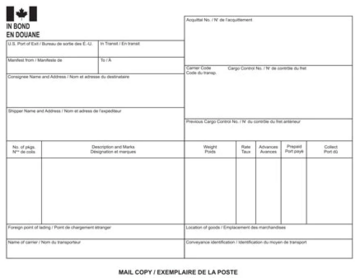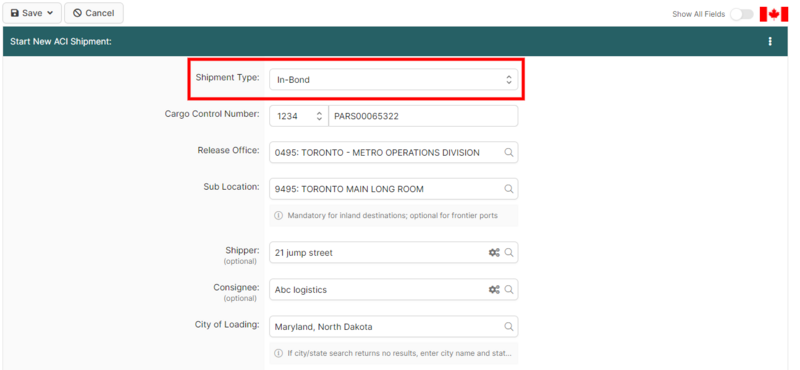In Bond (CBSA Shipment Type)
| This article is part of the Shipment Release Types Guide and the BorderConnect ACI eManifest Guide |
| This article is about the Canadian In-Bond Shipment Type. For information on the U.S. Shipment Type visit In-Bond Shipment (CBP Shipment Type) |

An In Bond is a Canadian Shipment Type for goods to clear through CBSA and ACI eManifest. It allows for the inland movement of goods that have not yet obtained Customs release.
The In Bond process begins when a carrier elects to put the shipment in bond rather than having it pre-cleared (i.e. PARS) or otherwise released at the border. This can be done for any number of logistical reasons or at the importer's request. The carrier declares the shipment as an In Bond when the driver arrives at the border by reporting the shipment as In Bond on their ACI eManifest and presenting a paper A8A form to the officer. CBSA will then authorize the movement of the goods, allowing them to delivered to a specified sufferance warehouse or another CBSA office to await Customs release. The carrier must then wait for a formal entry to be filed by the Customs Broker before the goods can be removed from the warehouse for delivery to the consignee.
Only a bonded highway carrier, a carrier provided in-bond authority or a carrier with a Temporary In-Bond from CBSA are entitled to use the In Bond process.
For more information on becoming a bonded carrier see the instructions on CBSA's website here.[1][2]
Declaring In Bond Shipments in ACI eManifest
In Bond shipments are required to be reported on an ACI eManifest. To report an In Bond Shipment the carrier will need to create an ACI Shipment designated as non-CSA (or In-Bond if using BorderConnect's ACI eManifest software), and ensure that the shipment is transmitted as part of their ACI eManifest.
When reporting an In Bond shipment in ACI, it is important to note that the Sub Location, which is normally optional, becomes a mandatory field and must be completed on both the manifest and shipment sections. An In Bond is also the only Shipment Type in which the Release Office should be different from the First Canadian Port of Entry. In this case the Release Office should be the customs office where the goods are expected to obtain release, i.e. the customs office that oversees the warehouse to which the goods are bonded. [3]
In addition to including the In Bond on the ACI eManifest, the driver is required to present a completed paper A8A to the officer at the border. The completed A8A must include the Cargo Control Number, but it is NOT required to be bar-coded as was the case prior to eManifest. [4]
Because In Bond goods are not released prior to arrival in Canada, the carrier will not receive a Transaction Number or other clearance information from the Customs Broker until well after the goods have both crossed the border, and been delivered to the sufferance warehouse.
| In order to comply with ACI eManifest requirements you are required to ensure that both your manifest and the broker clearance on any PARS shipments are on file with CBSA for at least one hour before the driver arrives at the border. |
References
- ↑ Customs D Memorandum D3-4-2 http://www.cbsa-asfc.gc.ca/publications/dm-md/d3/d3-4-2-eng.pdf
- ↑ Customs D Memorandum D3-1-1 http://www.cbsa-asfc.gc.ca/publications/dm-md/d3/d3-1-1-eng.pdf
- ↑ ACI eManifest Highway ECCRD http://www.cbsa-asfc.gc.ca/prog/manif/eccrd-decce-1-eng.pdf
- ↑ CBSA Requirements for Commercial Clients https://www.cbsa-asfc.gc.ca/eservices/eccrd-eng.html

